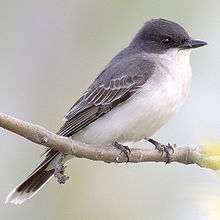Eastern kingbird
| Eastern kingbird | |
|---|---|
 | |
| Adult | |
| Scientific classification | |
| Kingdom: | Animalia |
| Phylum: | Chordata |
| Class: | Aves |
| Order: | Passeriformes |
| Family: | Tyrannidae |
| Genus: | Tyrannus |
| Species: | T. tyrannus |
| Binomial name | |
| Tyrannus tyrannus (Linnaeus, 1758) | |
 | |
| T. tyrannus range Breeding range Wintering range | |
The eastern kingbird (Tyrannus tyrannus) is a large tyrant flycatcher native to North America.
Physical description
Adults are grey-black on the upperparts with light underparts; they have a long black tail with a white end and long pointed wings. They have a red patch on their crown, seldom seen. They are of average size for a kingbird, at 19–23 cm (7.5–9.1 in), 33–38 cm (13–15 in) across the wings and weighing 33–55 g (1.2–1.9 oz).[2]
The call is a high-pitched, buzzing and unmusical chirp, frequently compared to an electric fence.[3]
Distribution and range
Their breeding habitat is open areas across North America. They make a sturdy cup nest in a tree or shrub, sometimes on top of a stump or pole. These birds aggressively defend their territory, even against much larger birds.[4]
These birds migrate in flocks to South America. There are three European records, two from Ireland in October 2012 and September 2013, and one from Scotland in September 2016.
Behavior
Eastern kingbirds wait on an open perch and fly out to catch insects in flight, sometimes hovering to pick food off vegetation. They also eat berries and fruit, mainly in their wintering areas.[5]
Some eastern kingbirds place their nests in the open while others hide nests very well. Eastern kingbirds in Southern British Columbia can nest in open fields; in shrubs over open water; high in tall trees and even in the tops of small stumps. Both male and female participate in nest defense, but females may stay on well-hidden nests longer than females with open nests who may leave nests earlier to chase away predators. Those pairs nesting in the open may be able to see predators coming earlier and rely on aggressive behavior to protect their young.
The aggressive behavior of eastern kingbirds has been shown to keep ravens and crows from finding experimental nests placed near kingbird nests. Similar experimental nests placed far from the kingbird nests were found far more often by crows and ravens. They can also recognize and remove cowbird eggs from their nests. Still, blue jays, American crows, squirrels, and tree-climbing snakes are on occasion nest predators. American kestrels are probable predators of adults.[6]
 |
Eastern kingbird Call
|
| Problems playing this file? See media help. | |
 Spots its prey
Spots its prey Attacks
Attacks Returns to exactly the same spot
Returns to exactly the same spot
Footnotes
- ↑ BirdLife International (2012). "Tyrannus tyrannus". IUCN Red List of Threatened Species. Version 2013.2. International Union for Conservation of Nature. Retrieved 26 November 2013.
- ↑ http://www.allaboutbirds.org/guide/Eastern_Kingbird/lifehistory
- ↑ http://bna.birds.cornell.edu/bna/species/253/articles/sounds
- ↑ "All About Birds: Eastern Kingbird". All About Birds. Cornell Lab of Ornithology. 2003. Retrieved 2008-08-12.
- ↑ E.g. of Gumbo-limbo, Bursera simaruba (Foster 2007).
- ↑ http://bna.birds.cornell.edu/bna/species/253/articles/behavior
References
- Foster, Mercedes S. (2007): The potential of fruiting trees to enhance converted habitats for migrating birds in southern Mexico. Bird Conservation International 17(1): 45-61. doi:10.1017/S0959270906000554 PDF fulltext
External links
| Wikimedia Commons has media related to Eastern Kingbird. |
| Wikispecies has information related to: Tyrannus tyrannus |
- Eastern Kingbird - Tyrannus tyrannus - USGS Patuxent Bird Identification InfoCenter
- Eastern Kingbird Species Account – Cornell Lab of Ornithology
-
 "Kingbird". Collier's New Encyclopedia. 1921.
"Kingbird". Collier's New Encyclopedia. 1921. - "Eastern Kingbird media". Internet Bird Collection.
- Eastern Kingbird photo gallery at VIREO (Drexel University)
